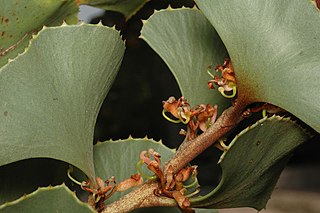
Hakea myrtoides, commonly known as myrtle hakea, is a shrub endemic to the woodlands of the Darling Range near Perth in Western Australia.

Hakea scoparia is a species of flowering plant in the family Proteaceae and is endemic to the south-west of Western Australia where it grows in shrubland. It is a shrub with ascending branches, terete leaves and clusters of cream to pinkish flowers in leaf axils from June to September.

Hakea erinacea, commonly known as hedgehog or porcupine hakea, is a shrub in the family Proteaceae endemic to south-west Western Australia.

Hakea trifurcata, commonly known as two-leaf, two-leaved hakea, or kerosene bush, is a shrub, endemic to the south-west of Western Australia. The species has two leaf forms, needle-like or oblong egg-shaped. Unlike most hakea species the fruit remain green at maturity and resemble the broader leaf form. The mimicry creates a camouflage, reducing predation of the seed by granivores in particular cockatoos.

Hakea cucullata, commonly known as hood-leaved hakea, cup hakea or scallop hakea, is a species of shrub in the family Proteaceae and is endemic to the south-west of Western Australia. It is an attractive shrub with distinctive foliage and beautiful large pink, red, or deep purple scented flowers.

Hakea ambigua is a shrub in the family Proteaceae. In favourable conditions may grow into an attractive weeping shrub with creamy white flowers. Only found in the Stirling Ranges of southern Western Australia.

Hakea brownii commonly known fan-leaf hakea is a shrub in the family Proteaceae native to an area in the Wheatbelt region of Western Australia. This species shares a common name with Hakea baxteri due to its distinctive leaves.

Hakea costata, commonly known as the ribbed hakea, is a shrub in the family Proteaceae native to Western Australia. A multi-stemmed small shrub producing attractive pink or white brush-like blooms rich in nectar from July to October.

Hakea erecta is a shrub in the family Proteaceae and is endemic to Western Australia. It is a dense rounded shrub with linear twisted leaves and up to 24 pink or white fragrant flowers appearing in leaf axils in spring.

Hakea francisiana, commonly called the emu tree, grass-leaf hakea or bottlebrush hakea, is a shrub or tree of the genus Hakea native to Western Australia and South Australia.

Hakea lehmanniana, commonly known as the blue hakea, is a shrub in the family Proteaceae. It has needle-shaped prickly leaves and blue flowers during winter months. It is endemic to an area in the southern Wheatbelt and Great Southern regions of Western Australia.

Hakea loranthifolia is a shrub of the family Proteaceae and is endemic to Western Australia. It has an open growth habit, stiff egg-shaped leaves with longitudinal veins, smooth grey bark and white flowers from July to September.

Hakea oleifolia, commonly known as dungyn, or the olive-leaved hakea, is a shrub or tree of the family Proteaceae and is endemic to an area along the south coast in the South West and Great Southern regions of Western Australia.

Hakea smilacifolia is a shrub in the family Proteaceae. It has sweetly scented flowers, stiff leathery leaves and is endemic to an area in the Mid West, western Wheatbelt and the Goldfields-Esperance regions of Western Australia.

Hakea subsulcata is a shrub in the family Proteaceae and is endemic to an area in the Wheatbelt, Great Southern and the Goldfields-Esperance regions of Western Australia. It is an upright, broom-like shrub with needle-shaped leaves and purple-pink flowers from winter to early spring.

Hakea sulcata, commonly known as furrowed hakea, is a flowering plant in the family Proteaceae and is endemic to Western Australia. It is a prickly shrub with grooved, cylindrical leaves, sweetly-scented flowers and relatively small fruit.
Grevillea pinifolia, commonly known as the pine-leaved grevillea, is a species of flowering plant in the family Proteaceae and is endemic to a restricted area in the south-west of Western Australia. It is a low, mounded shrub with linear, more or less cylindrical leaves and red to orange-red flowers.

Grevillea teretifolia, commonly known as round leaf grevillea, is species of flowering plant in the family Proteaceae and is endemic to the southwest of Western Australia. It is an erect to spreading shrub with many stems, divided leaves, the end lobes sharply pointed and more or less cylindrical, and clusters of white or pale pink flowers.

Thomasia angustifolia, commonly known as narrow-leaved thomasia, is a species of flowering plant in the family Malvaceae and is endemic to the south-west of Western Australia. It has densely hairy young stems, narrowly oblong, wrinkled leaves and pinkish-purple, bell-shaped flowers.

Andersonia heterophylla is a species of flowering plant in the family Ericaceae and is endemic to the south-west of Western Australia. It is an erect or ascending shrub with egg-shaped to more or less linear leaves and white or pink flowers.




















